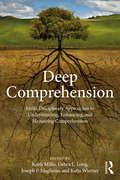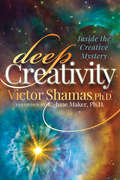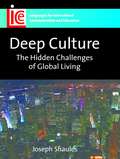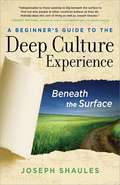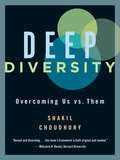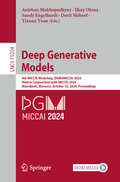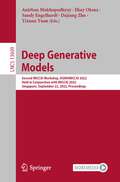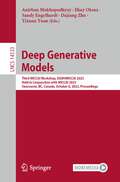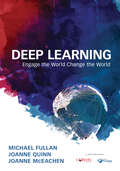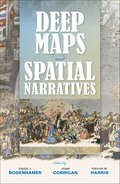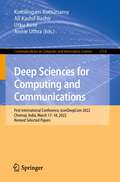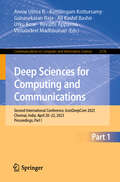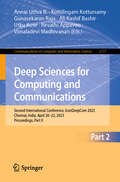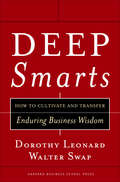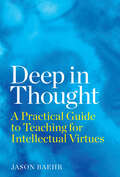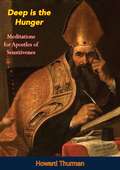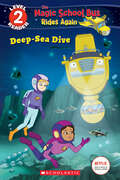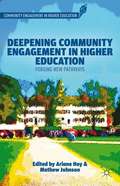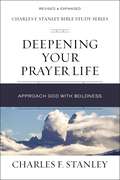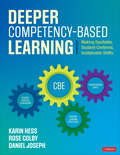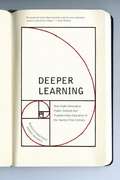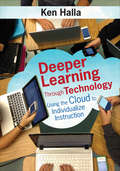- Table View
- List View
Deep Comprehension: Multi-Disciplinary Approaches to Understanding, Enhancing, and Measuring Comprehension
by Debra Long Keith K. Millis Joseph Magliano Katja WiemerThis volume provides an overview of research from the learning sciences into understanding, enhancing, and measuring "deep comprehension" from a psychological, educational, and psychometric perspective. It describes the characteristics of deep comprehension, what techniques may be used to improve it, and how deep levels of comprehension may be distinguished from shallow ones. It includes research on personal-level variables; how intelligent tutors promote comprehension; and the latest developments in psychometrics. The volume will be of interest to senior undergraduate and graduate students of cognitive psychology, learning, cognition and instruction, and educational technology.
Deep Creativity: Inside the Creative Mystery
by Victor ShamasDeep Creativity reveals the findings of Victor Shamas’ 30-year exploration of the creative process. Rather than observing creativity in others, he delved into the experience directly in order to uncover hidden truths and break free of common misconceptions. Deep Creativity turns fundamental assumptions about creativity on their head while offering fresh perspectives on the scientific method, fractals, Maslow’s hierarchy of needs, plate tectonics, mind and consciousness, hero myths, the life cycle, sleep and dreams, mothers’ intuition, the nature of wisdom, peak experiences, and even the Gospels. Written from a research psychologist’s perspective, Deep Creativity portrays the creative experience as a bold adventure filled with passion, turmoil, inspiration, sacrifice, sheer joy, self-transcendence, and unconditional love.
Deep Culture
by Joseph ShaulesA straightforward guide to understanding the hidden cultural challenges of adapting to life abroad. Combining intercultural theory and the voices of sojourners who talk about their experiences, it maps out the process of resisting, accepting and adapting to cultural difference. We see that all sojourners, from tourists, to expatriates to immigrants, go through a similar learning dynamic. We learn that intercultural experiences can be deep or shallow, and that hidden cultural difference can increase sojourner prejudice. The book examines intercultural sensitivity while avoiding "feel good" idealizations about cross-cultural contact. It brings clarity to debates regarding the importance of cultural difference and the effects of globalization. An essential resource for sojourners, language teachers and intercultural educators.
Deep Culture Experience: Beneath The Surface
by Joseph ShaulesShaules proposes the idea of a "deep culture journey,” in which travelers pursue not only the surface of travel, but the entire cross-cultural experience. Including an accessible introduction to traveling internationally for business or work while simultaneously enjoying the hidden culture beneath the surface, Shaules emphasizes that experiences abroad can teach us more about ourselves.
Deep Diversity: Overcoming Us vs. Them
by Shakil ChoudhuryWhat if our interactions with those different from us are strongly influenced by things happening below the radar of awareness, hidden even from ourselves? Deep Diversity explores this question and argues that "us vs. them" is an unfortunate but normal part of the human experience due to reasons of both nature and nurture.To really work through issues of racial difference and foster greater levels of fairness and inclusion, argues Shakil Choudhury, requires an understanding of the human mind—its conscious and unconscious dimensions. Deep Diversity integrates Choudhury’s twenty years of experience with interviews with researchers in social neuroscience, implicit bias, psychology, and mindfulness. Using a compassionate but challenging approach, Choudhury helps readers identify their own bias and offers practical ways to break the "prejudice habits" we have all learned, in order to tackle systemic discrimination.
Deep Generative Models: 4th MICCAI Workshop, DGM4MICCAI 2024, Held in Conjunction with MICCAI 2024, Marrakesh, Morocco, October 10, 2024, Proceedings (Lecture Notes in Computer Science #15224)
by Anirban Mukhopadhyay Sandy Engelhardt Ilkay Oksuz Yixuan Yuan Dorit MehrofThis book constitutes the proceedings of the 4th workshop on Deep Generative Models for Medical Image Computing and Computer Assisted Intervention, DGM4MICCAI 2024, held in conjunction with the 27th International conference on Medical Image Computing and Computer Assisted Intervention, MICCAI 2024, in Marrakesh, Morocco in October 2024. The 21 papers presented here were carefully reviewed and selected from 40 submissions. These papers deal with a broad range of topics, ranging from methodology (such as Causal inference, Latent interpretation, Generative factor analysis) to Applications (such as Mammography, Vessel imaging, Surgical videos and more).
Deep Generative Models: Second MICCAI Workshop, DGM4MICCAI 2022, Held in Conjunction with MICCAI 2022, Singapore, September 22, 2022, Proceedings (Lecture Notes in Computer Science #13609)
by Anirban Mukhopadhyay Dajiang Zhu Sandy Engelhardt Ilkay Oksuz Yixuan YuanThis book constitutes the refereed proceedings of the Second MICCAI Workshop on Deep Generative Models, DG4MICCAI 2022, held in conjunction with MICCAI 2022, in September 2022. The workshops took place in Singapore. DG4MICCAI 2022 accepted 12 papers from the 15 submissions received. The workshop focusses on recent algorithmic developments, new results, and promising future directions in Deep Generative Models. Deep generative models such as Generative Adversarial Network (GAN) and Variational Auto-Encoder (VAE) are currently receiving widespread attention from not only the computer vision and machine learning communities, but also in the MIC and CAI community.
Deep Generative Models: Third MICCAI Workshop, DGM4MICCAI 2023, Held in Conjunction with MICCAI 2023, Vancouver, BC, Canada, October 8, 2023, Proceedings (Lecture Notes in Computer Science #14533)
by Anirban Mukhopadhyay Dajiang Zhu Sandy Engelhardt Ilkay Oksuz Yixuan YuanThis LNCS conference volume constitutes the proceedings of the third MICCAI Workshop, DGM4MICCAI 2023, Held in Conjunction with MICCAI 2023, Vancouver, BC, Canada, October 2023. The 23 full papers included in this volume were carefully reviewed and selected from 38 submissions.The conference presents topics ranging from methodology, causal inference, latent interpretation, generative factor analysis to applications such as mammography, vessel imaging, and surgical Videos.
Deep Learning: Engage the World Change the World
by Michael Fullan Joanne Quinn Joanne J. McEachenEngage the World Change the World Deep Learning has claimed the attention of educators and policymakers around the world. This book not only defines what deep learning is, but takes up the question of how to mobilize complex, whole-system change and transform learning for all students. Deep Learning is a global partnership that works to: transform the role of teachers to that of activators who design experiences that build global competencies using real-life problem solving; and supports schools, districts, and systems to shift practice and how to measure learning in authentic ways. This comprehensive strategy incorporates practical tools and processes to engage students, educators, and families in new partnerships and drive deep learning. Inside you’ll find: The Deep Learning Framework Vignettes and case studies from K-12 classrooms in 1,200 schools in seven countries Guidance for reaching disadvantaged and differently abled students Sample protocols and rubrics for assessment Videos demonstrating deep learning design and innovative leadership in practice Through learning partnerships, learning environments, new pedagogical practices, and leveraged digital skills, deep learning reaches students as never before — preparing them to be active, engaged participants in their future.
Deep Learning: Engage the World Change the World
by Michael Fullan Joanne Quinn Joanne J. McEachenEngage the World Change the World Deep Learning has claimed the attention of educators and policymakers around the world. This book not only defines what deep learning is, but takes up the question of how to mobilize complex, whole-system change and transform learning for all students. Deep Learning is a global partnership that works to: transform the role of teachers to that of activators who design experiences that build global competencies using real-life problem solving; and supports schools, districts, and systems to shift practice and how to measure learning in authentic ways. This comprehensive strategy incorporates practical tools and processes to engage students, educators, and families in new partnerships and drive deep learning. Inside you’ll find: The Deep Learning Framework Vignettes and case studies from K-12 classrooms in 1,200 schools in seven countries Guidance for reaching disadvantaged and differently abled students Sample protocols and rubrics for assessment Videos demonstrating deep learning design and innovative leadership in practice Through learning partnerships, learning environments, new pedagogical practices, and leveraged digital skills, deep learning reaches students as never before — preparing them to be active, engaged participants in their future.
Deep Maps and Spatial Narratives (The Spatial Humanities)
by John Corrigan David J. Bodenhamer Trevor M. HarrisDeep maps are finely detailed, multimedia depictions of a place and the people, buildings, objects, flora, and fauna that exist within it and which are inseparable from the activities of everyday life. These depictions may encompass the beliefs, desires, hopes, and fears of residents and help show what ties one place to another. A deep map is a way to engage evidence within its spatio-temporal context and to provide a platform for a spatially-embedded argument. The essays in this book investigate deep mapping and the spatial narratives that stem from it. The authors come from a variety of disciplines: history, religious studies, geography and geographic information science, and computer science. Each applies the concepts of space, time, and place to problems central to an understanding of society and culture, employing deep maps to reveal the confluence of actions and evidence and to trace paths of intellectual exploration by making use of a new creative space that is visual, structurally open, multi-media, and multi-layered.
Deep Sciences for Computing and Communications: First International Conference, IconDeepCom 2022, Chennai, India, March 17–18, 2022, Revised Selected Papers (Communications in Computer and Information Science #1719)
by Utku Kose Ali Kashif Bashir Kottilingam Kottursamy Annie UthraThis book constitutes selected papers presented during the First International Conference on Deep Sciences for Computing and Communications, IconDeepCom 2022, held in Chennai, India, in March 2022.The 27 papers presented were thoroughly reviewed and selected from 97 submissions. They are organized in topical sections as follows: classification and regression problems for communication paradigms; deep learning and vision computing; deep- recurrent neural network (RNN) for industrial informatics; extended AI for heterogeneous edge.
Deep Sciences for Computing and Communications: Second International Conference, IconDeepCom 2023, Chennai, India, April 20–22, 2023, Proceedings, Part I (Communications in Computer and Information Science #2176)
by Utku Kose Ali Kashif Bashir Kottilingam Kottursamy Annie Uthra R. Gunasekaran Raja Revathi Appavoo Vimaladevi MadhivananThis two-volume set, CCIS 2176-2177, constitutes the proceedings from the Second International Conference on Deep Sciences for Computing and Communications, IconDeepCom 2023, held in Chennai, India, in April 2023. The 74 full papers and 8 short papers presented here were thoroughly reviewed and selected from 252 submissions. The papers presented in these two volumes are organized in the following topical sections: Part I: Applications of Block chain for Digital Landscape; Deep Learning approaches for Multipotent Application; Machine Learning Techniques for Intelligent Applications; Industrial use cases of IOT; NLP for Linguistic Support; Convolution Neural Network for Vision Applications. Part II: Optimized Wireless Sensor Network Protocols; Cryptography Applications for Enhanced Security; Implications of Networking on Society; Deep Learning Model for Health informatics; Web Application for Connected Communities; Intelligent Insights using Image Processing; Precision Flood Prediction Models.
Deep Sciences for Computing and Communications: Second International Conference, IconDeepCom 2023, Chennai, India, April 20–22, 2023, Proceedings, Part II (Communications in Computer and Information Science #2177)
by Utku Kose Ali Kashif Bashir Kottilingam Kottursamy Annie Uthra R. Gunasekaran Raja Revathi Appavoo Vimaladevi MadhivananThis two-volume set, CCIS 2176-2177, constitutes the proceedings from the Second International Conference on Deep Sciences for Computing and Communications, IconDeepCom 2023, held in Chennai, India, in April 2023. The 74 full papers and 8 short papers presented here were thoroughly reviewed and selected from 252 submissions. The papers presented in these two volumes are organized in the following topical sections: Part I: Applications of Block chain for Digital Landscape; Deep Learning approaches for Multipotent Application; Machine Learning Techniques for Intelligent Applications; Industrial use cases of IOT; NLP for Linguistic Support; Convolution Neural Network for Vision Applications. Part II: Optimized Wireless Sensor Network Protocols; Cryptography Applications for Enhanced Security; Implications of Networking on Society; Deep Learning Model for Health informatics; Web Application for Connected Communities; Intelligent Insights using Image Processing; Precision Flood Prediction Models.
Deep Smarts
by Dorothy Leonard Walter SwapThe asset most valuable to your company's future is lost every time an employee leaves the firmThis asset is more than knowledge, and it is more than intelligence-it is "deep smarts": the tacit "know-how" and expertise that comes only from years of hands-on experience. This book focuses on how to cultivate and harness deep smarts so that it stays in the firm, even if your employees don't.
Deep in Thought: A Practical Guide to Teaching for Intellectual Virtues
by Jason BaehrDeep in Thought provides an introduction to intellectual virtues—the personal qualities and character strengths of good thinkers and learners—and outlines a pragmatic approach for teachers to reinforce them in the classroom.With a combination of theoretical expertise and practical experience, philosopher Jason Baehr endorses intellectual virtues as a rich, meaningful way to think about and understand the purpose of education. He makes a persuasive case for prioritizing intellectual virtues in the classroom to facilitate deeper learning, encourage lifelong learning, and enrich teacher practice.Baehr profiles nine key virtues that enable learners to initiate the process of learning, maintain forward momentum, and overcome common obstacles. With engaging anecdotes and concrete examples, he presents a wealth of principles, postures, and practices that educators can employ in promoting essential habits of mind such as curiosity, open-mindedness, and intellectual courage. Baehr illustrates how opportunities to practice these intellectual habits can be integrated into the classroom in ways that align with current teaching practices. In addition, he shows how educators can adapt these practices to accommodate students&’ identities, developmental abilities, and interests.This thought-provoking book supports all educators, especially middle and high school teachers, in teaching for intellectual virtues. Deep in Thought is a philosophical and yet practical guide to one of the most important aims of education: helping students become skilled thinkers and learners.
Deep is the Hunger: Meditations for Apostles of Sensitiveness
by Howard ThurmanHoward Thurman, the Pastor of The Church for the Fellowship of all Peoples, was one of San Francisco’s most sought-after preachers at college chapels. His contribution to the large audiences he addressed each year across the country and to his own inter-racial congregation consisted not only of prophetic quality, but also of an ability to lead a group into an atmosphere of devotion.In Deep is the Hunger: Meditations for Apostles of Sensitiveness, Dr. Thurman provides the devotional reader with twenty-five working papers for meditations, which grew out of his weekly messages at The Church for the Fellowship of All Peoples. The book is divided into four parts: (1) A sense of history; (2) A sense of self; (3) A sense of presence; and (4) For the quiet time.“The attempt is not to set forth a connected series of observations or reflections, but rather to throw a shaft of light on aspects of thought, of life, of religious experience, as they are encountered in the daily round.”—Howard Thurman, Preface“This is a book of rare quality, indeed, admirably suited for use during the season for personal or group devotions…Dr. Thurman has an unusual and extraordinary gift for using the penetrating word, phrase and illustration…This book and the meditations deal with problems everyone can all relate to…One of the best devotional books of the year.”—Kirkus Review
Deep-Sea Dive (Scholastic Reader, Level 2)
by Samantha BrookeSeatbelts, everyone. Next stop...under the sea in this beginning reader packed with fun science facts. Based on the NETFLIX animated series!When Dorothy Ann accidentally loses Jyoti's high-tech locket in the ocean, it's all aboard the Magic School Submarine to retrieve it! Down they go through the layers of the sea, amazed by some of Earth's most unusual animals. But when their bus loses power at the darkest depths, can the kids find inspiration from the creatures they find there to turn their luck around?
Deepening Community Engagement In Higher Education
by Ariane Hoy Mathew JohnsonThis volume argues for reexamination of the field of community engagement, suggests that the most effective way forward requires rethinking the structures of traditional higher education, and points to the growing emergence of evidence-based best practices that can catalyze a renaissance in community engagement and in higher education.
Deepening Your Prayer Life: Approach God with Boldness (Charles F. Stanley Bible Study Series)
by Charles F. StanleyListening and speaking to God.Prayer is communication. It is not a formula that we have memorized, or an empty repetition of words and phrases, but our conversation with God–with us first speaking and then listening to what God has to say to us in return. However, as Dr. Charles Stanley reveals in Deepening Your Prayer Life, our prayers go beyond mere human interaction in that it gives us access into the very throne room of God. Our heavenly Father grants us the privilege to come before him with authority because of our position in Christ. When we do, we can be bold in believing that God will accomplish what He promised He would do in our lives.The Charles F. Stanley Bible Study Series is a unique approach to Bible study, incorporating biblical truth, personal insights, emotional responses, and a call to action. Each study draws on Dr. Stanley&’s many years of teaching the guiding principles found in God&’s Word, showing how we can apply them in practical ways to every situation we face. This edition of the series has been completely revised and updated, and includes two brand-new lessons from Dr. Stanley.Each lesson includes:Overview: A brief look at what is covered in the lessonLife&’s Questions: A teaching from Dr. Stanley that unpacks the topic of the lessonLiving the Principle: Application and Bible study questions based on the key pointsReflection: Key takeaways to put into practice today and tomorrow
Deeper Competency-Based Learning: Making Equitable, Student-Centered, Sustainable Shifts
by Karin J. Hess Rose L. Colby Daniel A. JosephThe roadmap for your school’s CBE journey! The one-size-fits-all instructional and assessment practices of the past no longer equitably meet the needs of all students. Competency-based education (CBE) has emerged not only as an innovation in education, but as a true transformation of the approaches to how we traditionally "do" school. In Deeper Competency-Based Learning, the authors share best practices from their experiences implementing CBE across states, districts, and schools. Leaving no stone unturned, readers are guided step-by-step through CBE implementation and validation phases, beginning with defining your WHY and collaborative development of the competencies describing deeper learning. The CBE readiness tools and reflections inside will help your team: Build the foundation for organizational shifts by examining policies, leadership, culture, and professional learning Dig in to shifts in teaching and learning structures by addressing rigorous learning goals, competency-based assessment, evidence-based grading, and body of evidence validation Take a deep dive into the shift to student-centered classrooms through personalized instructional strategies that change mindsets regarding teacher-student roles, responsibilities, and classroom culture Discover how your students can demonstrate deeper learning of academic content and develop personal success skills by maximizing time, place, and pace of learning with this roadmap for your CBE journey.
Deeper Competency-Based Learning: Making Equitable, Student-Centered, Sustainable Shifts
by Karin J. Hess Rose L. Colby Daniel A. JosephThe roadmap for your school’s CBE journey! The one-size-fits-all instructional and assessment practices of the past no longer equitably meet the needs of all students. Competency-based education (CBE) has emerged not only as an innovation in education, but as a true transformation of the approaches to how we traditionally "do" school. In Deeper Competency-Based Learning, the authors share best practices from their experiences implementing CBE across states, districts, and schools. Leaving no stone unturned, readers are guided step-by-step through CBE implementation and validation phases, beginning with defining your WHY and collaborative development of the competencies describing deeper learning. The CBE readiness tools and reflections inside will help your team: Build the foundation for organizational shifts by examining policies, leadership, culture, and professional learning Dig in to shifts in teaching and learning structures by addressing rigorous learning goals, competency-based assessment, evidence-based grading, and body of evidence validation Take a deep dive into the shift to student-centered classrooms through personalized instructional strategies that change mindsets regarding teacher-student roles, responsibilities, and classroom culture Discover how your students can demonstrate deeper learning of academic content and develop personal success skills by maximizing time, place, and pace of learning with this roadmap for your CBE journey.
Deeper Experiences of Famous Christians: Gleaned From Their Biographies, Autobiographies And Writings
by James Gilchrist Lawson"Deeper Experiences of Famous Christians" by James Gilchrist Lawson is an inspiring and enlightening collection of spiritual biographies that delves into the profound and transformative experiences of some of the most influential figures in Christian history. Lawson, a respected Christian author and historian, brings together the stories of men and women whose deep faith and extraordinary encounters with God have left an indelible mark on the Christian faith.Among the figures featured are saints like Augustine and Francis of Assisi, reformers such as Martin Luther and John Wesley, and revivalists like Jonathan Edwards and Charles Finney. Lawson meticulously recounts their struggles, revelations, and the divine interventions that led them to a deeper understanding of God's love and purpose for their lives. Through these stories, readers are given a window into the inner workings of God's grace and the ways in which He shapes and molds His servants."Deeper Experiences of Famous Christians" is not just a historical account; it is a source of spiritual inspiration and encouragement. Lawson's engaging and accessible writing style brings these historical figures to life, making their experiences relatable and applicable to contemporary readers. The book serves as a powerful reminder that the same God who worked in the lives of these great Christians is still active and present today, inviting all believers to seek a deeper, more intimate relationship with Him.This book is an invaluable resource for anyone seeking to deepen their faith and understand the rich heritage of Christian spirituality. It is ideal for personal devotions, small group studies, and anyone interested in the lives of those who have profoundly influenced the course of Christianity. "Deeper Experiences of Famous Christians" offers timeless wisdom and inspiration, encouraging readers to pursue their own deeper experiences with God.
Deeper Learning
by Dennis Mcgrath Monica MartinezStudies suggest that up to half of high school dropouts leave school because their classes are boring or irrelevant to their lives and aspirations. Yet the majority of U.S. schools continue their attempts to engage some 50 million students through conventional methods such as lectures, note-taking, and rote learning, often with dismal results. In Deeper Learning, award-winning education strategist Monica Martinez and education sociologist Dennis McGrath offer a transformative framework for learning that has led to standout results in schools across the country and has the potential to support the development and success of every student.Through examples from eight public schools, the authors chart the path to crafting flexible learning environments that meet the widely varied needs of individual students. They showcase interactive approaches that compel students to learn how to learn and provide an invaluable guide for teachers and communities wondering how their schools will be able to adapt to the Common Core standards and new assessments. Above all, Deeper Learning shows how inspired, engaging education does not have to be the province of elite private schools and how all young people can become creators, collaborators, and critical thinkers.
Deeper Learning Through Technology: Using the Cloud to Individualize Instruction
by Kenneth P. HallaUse the Cloud to Individualize Your Instruction and Watch Your Students Thrive! The advent of cloud-stored data that can be entered, changed, and accessed anywhere is a development full of potential for today’s classroom. This book is the all-in-one resource you need to be sure your students reap the fullest rewards from cloud-based developments. Teacher and top ed-blogger Ken Halla explains: Strategies for leveraging the cloud to create a self-paced, learner-centered classroom How to take advantage of tech tools to facilitate learning Real-life case studies and activities to ensure an enjoyable implementation experience. Stay ahead of the curve with Ken Halla’s strategies, which you can implement the next morning. "Halla′s book, written from practitioner experience, provides practical and simple integration techniques that will assist both novice and experienced teachers incorporate technology to enhance student learning." —Eric Sheninger, author of Digital Leadership, Changing Paradigms for Changing Times "This is a must read--a detailed nuts and bolts guide to classroom tools in the cloud." —Michael B. Horn, Co-Founder and Director, Christensen Institute Author of Disrupting Class: How Disruptive Innovation Will Change the Way the World Learns. "Whether you are an ed tech veteran or just getting started, Halla′s book will help you tailor learning to meet the needs of your students. This book will help you create the learner-focused classroom you want to build! A must-have resource for today′s teachers!" —Jaime Casap, Global Education Evangelist Google
